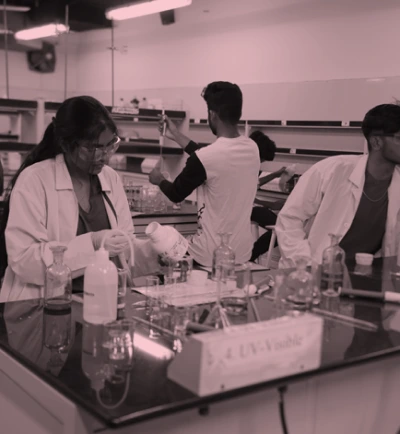
Nayana Mukherjee
Assistant Professor
nayana.mukherjee@mahindrauniversity.edu.in
Nayana Mukherjee is an Assistant Professor in the Mathematics department at École Centrale School of Engineering, Mahindra University. She has completed her Ph.D. in Mathematics from Indian Institute of Technology Kanpur, on June 2019. Her research interests are in Mathematical Biology, Spatio-temporal pattern formation, Mathematical modeling, Ordinary and Partial differential equations, Population ecology, Eco-epidemiology and other fields of application of Mathematics.
Ph.D.
- Ph.D. in Mathematics from Indian Institute of Technology Kanpur, Kanpur, India, June 2019.
M.Sc.
- M.Sc. in Mathematics & Computing from Indian School of Mines (IIT-ISM), Dhanbad, Jharkhand, India, July 2013.
B.Sc.
- B.Sc. in Mathematics from Presidency College under University of Calcutta, Kolkata, West Bengal, India, July 2011.
Schooling
- Schooling from Nava Nalanda group of schools, Kolkata, West Bengal, India in June 2008.
Present
- Nayana Mukherjee is an Assistant Professor in the Mathematics department at École Centrale School of Engineering, Mahindra University.
January, 2023 to June, 2024
- Institute post-doctoral fellow in Tata Institute of Fundamental Research, Hyderabad, India. (January, 2023 to June, 2024)
January, 2021 to January, 2023
- National Post-doctoral fellow (SERB-NPDF) in the Computational Biology group, Institute of Mathematical Sciences, Chennai, India. (January, 2021 to January, 2023)
July, 2019 to December, 2020
- Institute post-doctoral fellow in the Computational Biology group, Institute of Mathematical Sciences, Chennai, India. (July, 2019 to December, 2020)
Publications
2024
- Mukherjee, & V. Volpert. ‘’Spatiotemporal dynamics in a model of immunodominance’’, Journal of Biological Systems, (2024), In press,
2023
- N. Mukherjee, S.R. Smith? & M. Haque, ”Spatio-temporal patterns resulting from a predator-based disease with immune prey”, Chaos, Solitons and Fractals, Volume 168, (2023) 113197.
2022
- N. Mukherjee & M. Banerjee, ”Hunting cooperation among slowly diffusing specialist predators can induce stationary Turing patterns”, Physica A: Statistical Mechanics and its Applications, Volume 599, 2022, 127417, ISSN 0378-4371, https://doi.org/10.1016/j.physa.2022.127417, (https://www.sciencedirect.com/science/article/pii/S0378437122003090)
2021
- Yadav, N. Mukherjee & M. Sen, ”Spatio temporal dynamics of a preypredator model with Allee effect in prey and hunting cooperation in a Holling type III functional response”, Nonlinear Dynamics, https://doi.org/10.1007/s11071-021-07066-y, (2021).
- N. Mukherjee, & V. Volpert. Bifurcation scenario of Turing patterns in prey-predator model with nonlocal consumption in the prey dynamics, Communications in Nonlinear Science and Numerical Simulation, 96 (2021) 105677.N. Mukherjee, & V. Volpert. Bifurcation scenario of Turing patterns in prey-predator model with nonlocal consumption in the prey dynamics, Communications in Nonlinear Science and Numerical Simulation, 96 (2021) 105677.
2020
- M. Banerjee, N. Mukherjee & V. Volpert, Prey-predator model with nonlocal and global consumption in the prey dynamics, Discrete and Continuous Dynamical Systems series S doi:10.3934/dcdss.2020180 (2020)
2019
- N. Mukherjee, S. Ghorai & M. Banerjee, Cross-diffusion induced Turing and non-Turing patterns in Rosenzweig-MacArthur model, Letters in Biomathematics https://doi.org/10.1080/23737867.2019.1585981 (2019)
- N. Mukherjee, S. Ghorai & M. Banerjee, Detection of Turing patterns in a three species food chain model via amplitude equation, Communications in Nonlinear Science and Numerical Simulation 69 (2019) 219-236
2018
- M. Banerjee, N. Mukherjee & V. Volpert, Prey-Predator Model with a Nonlocal Bistable Dynamics of Prey, Mathematics 6 (2018)
- N. Mukherjee, S. Ghorai & M. Banerjee, Effects of density dependent cross-diffusion on the chaotic patterns in a ratio-dependent prey-predator model, Ecological Complexity 36 (2018) 276-289
- M. Banerjee, S. Ghorai & N. Mukherjee, Study of cross-diffusion induced Turing patterns in a ratio-dependent prey-predator model via amplitude equations, Applied Mathematical Modelling 55 (2018) 383-399
2017
- M. Banerjee, S. Ghorai & N. Mukherjee, Approximated Spiral and Target Patterns in Bazykin’s Prey–Predator Model: Multiscale Perturbation Analysis, International Journal of Bifurcation and Chaos, 27 (2017) 1750038
She works primarily in Applied Mathematics and her research interests include Mathematical Biology, Spatio-temporal pattern formation, Mathematical modeling, Ordinary and Partial differential equations, Population ecology, Eco-epidemiology and other fields of application of Mathematics. Interdisciplinary is the new way of research according to her.









